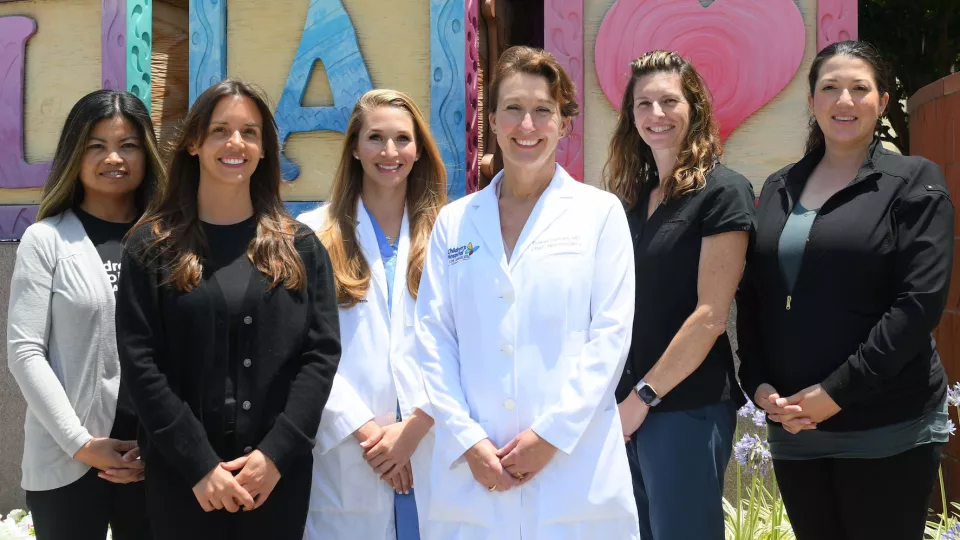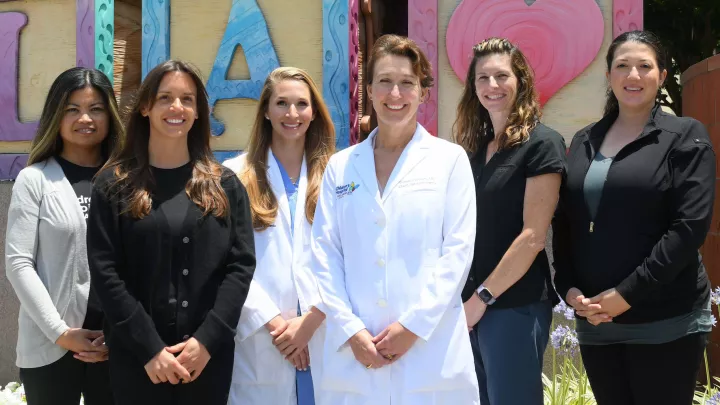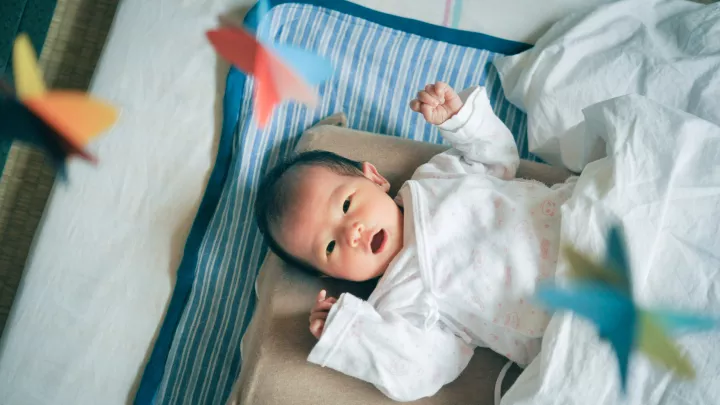
Members of the Brachial Plexus and Peripheral Nerve Program team at CHLA. L-R: Marielle Pascual, OTR/L; Nicole Mueske, MS, MHS, PA-C; Erin Meisel, MD, FAAOS; Susan Durham, MD, MS; Kim Loffredo, OTR/L, CHT; and Chantal Olenczuk, OTR/L, CHT.
Why Traditional Thinking on Brachial Plexus Birth Injuries Is Wrong
It’s often said that most brachial plexus birth injuries are mild and will heal on their own. But the reality is more complicated—and not as reassuring.
“It’s true that many babies will spontaneously recover. But babies who recover on their own typically get better very early, in the first two to three weeks of life,” says Erin Meisel, MD, FAAOS, a pediatric orthopedic surgeon at Children’s Hospital Los Angeles. “Beyond the first couple of weeks, a wait-and-see strategy can be very dangerous.”
Dr. Meisel and Chief of Neurosurgery Susan Durham, MD, MS, co-direct the Brachial Plexus and Peripheral Nerve Program at Children’s Hospital Los Angeles—the largest such program on the West Coast. The integrated, multidisciplinary team sees more than 300 patients a year.
Unfortunately, many of those babies aren’t referred to the team until they are 6 or 9 months old—or even older.
“Sometimes we can make up for lost time,” says Dr. Durham, Co-Director of the Neurological Institute and the J. Gordon McComb Family Chair in Neurosurgery at CHLA. “But not always.”
Early care is critical
The brachial plexus is a network of nerves in the neck and shoulder that connect the brain and spinal cord to the arms and hands. An injury to these nerves during birth can cause muscle weakness, loss of feeling or even complete paralysis in the affected arm or hand.
That’s why babies should be referred in the first weeks of life to a center like Children’s Hospital Los Angeles, which offers comprehensive, multidisciplinary surgical and nonsurgical care. Surgery typically needs to occur within the first year of life, but occupational therapy should start as soon after birth as possible.
“This is a nerve injury, so we have a very narrow window for treatment,” Dr. Meisel says. “Joint contractures can happen very quickly. The whole arm can develop abnormal growth and function very quickly. By age 6 months, a shoulder can already be dislocated; muscles can be dead.”
Signs to look for
Physicians should promptly refer babies who have symptoms or risk factors such as:
- Asymmetric use of the arms
- Shoulder dystocia (the baby’s shoulder was stuck in the birth canal)
- An arm or collarbone fracture at birth
- Prolonged labor or use of instruments to deliver the baby
- A mom with gestational diabetes
- A large birthweight (greater than 4 kilograms, or 8.8 pounds)
It’s also important not to try to wrap the arm to “protect” the injury. This restricts opportunities for a baby to move the affected arm.
The role of specialized therapy
Occupational therapy is a vital part of treatment. Although therapy does not cure the nerve injury, in a few cases—if started early—it can mitigate the need for surgery. It also plays a major role in a child’s outcomes.
At Children’s Hospital Los Angeles, occupational therapists are key members of the brachial plexus team and are specially trained to use modalities like electrical stimulation, which can help “wake up” a baby’s muscles before surgery and promote postoperative recovery.
“It’s our job to get babies to attend to the arm, to touch and feel it, so we can start developing a connection between the arm and the brain,” says Kim Loffredo, OTR/L, CHT, one of the team’s occupational therapists. “We also look at how the injury is affecting the entire development of the child.”
Nerve transfer innovations
Not every child with a non-transient brachial plexus injury will need surgery—but most will. Fortunately, surgical options are continuing to improve.
In addition to traditional nerve grafts, nerve transfers are becoming more common and advanced. In a nerve transfer, surgeons “rewire a limb”—borrowing a portion of a motor nerve from a healthy muscle and connecting it directly to the nerve of the muscle they need to activate.
The CHLA team is helping to lead the way in new nerve transfer innovations. At the Pediatric Hand Study Group meeting this spring, Dr. Meisel presented data from CHLA on the world’s largest case series of medial pectoral nerve to axillary nerve transfers in children with brachial plexus birth palsy. The data showed that, two years after the transfer, patients’ shoulder flexion and abduction function scores more than doubled.
An integrated team
At CHLA, brachial plexus care is an integrated, tightly woven collaboration between Orthopedic Surgery, Neurosurgery, Neurology and occupational therapy.
Specialists from these disciplines not only see patients together, in the same clinic, but they also collaborate on treatment decisions. In addition, neurologists diagnose and manage associated neurological conditions and conduct detailed electromyography (EMG) tests to evaluate the health and function of muscles and their related nerves. Nursing and social work also play important roles.
Even the surgeries are multidisciplinary at CHLA, with Dr. Meisel and Dr. Durham operating together on each case. Many of the later-stage surgeries, such as tendon or muscle transfers, are performed by Dr. Meisel and Milan Stevanovic, MD.
“Our team can take babies who can’t use their arm at all, and we can give them back a functional arm, where they can grab and hold things, feed themselves, swing on the monkey bars and more. It’s incredibly impactful for a child’s life,” says Dr. Durham. “But that’s not just about surgery. We all work together to provide the best care for each child and family.”


